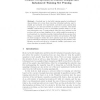Free Online Productivity Tools
i2Speak
i2Symbol
i2OCR
iTex2Img
iWeb2Print
iWeb2Shot
i2Type
iPdf2Split
iPdf2Merge
i2Bopomofo
i2Arabic
i2Style
i2Image
i2PDF
iLatex2Rtf
Sci2ools
IBPRIA
2005
Springer
2005
Springer
Parallel Perceptrons, Activation Margins and Imbalanced Training Set Pruning
A natural way to deal with training samples in imbalanced class problems is to prune them removing redundant patterns, easy to classify and probably over represented, and label noisy patterns that belonging to one class are labelled as members of another. This allows classifier construction to focus on borderline patterns, likely to be the most informative ones. To appropriately define the above subsets, in this work we will use as base classifiers the so–called parallel perceptrons, a novel approach to committee machine training that allows, among other things, to naturally define margins for hidden unit activations. We shall use these margins to define the above pattern types and to iteratively perform subsample selections in an initial training set that enhance classification accuracy and allow for a balanced classifier performance even when class sizes are greatly different.
IBPRIA 2005 | Image Analysis | Imbalanced Class Problems | Label Noisy Patterns | Redundant Patterns |
| Added | 29 Jun 2010 |
| Updated | 29 Jun 2010 |
| Type | Conference |
| Year | 2005 |
| Where | IBPRIA |
| Authors | Iván Cantador, José R. Dorronsoro |
Comments (0)

